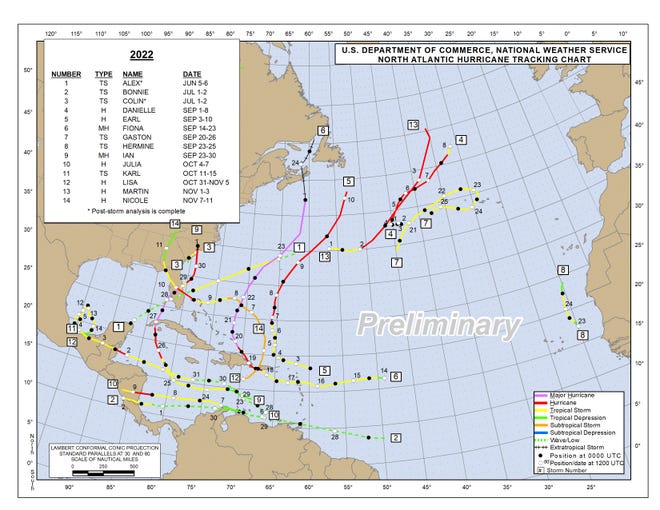
Mostly playing out over six weeks in the fall and an unmitigated disaster, 2022 was the Liz Truss of hurricane seasons.
Whether defined as the six weeks from early September to mid-October in which the Caribbean and southern Gulf saw numerous storms, or the six weeks between Hurricanes Ian and Nicole in Florida, 2022 administered its suffering in a concentrated dose. And while it tallied near-average activity overall, 2022 was once again above normal for U.S. landfalls.
Fortunately, like British Prime Minister Truss, CNN+, and various gryftocurrencies, hurricane season is finished.
DeSantis:Hurricspanne Nicole no compspanrison to ferocious Hurricspanne Ispann
What happened?:A vspanst mspanjority of Hurricspanne Ispann despanths were elderly Floridispanns

Tropical activity can occur after the official end of the season on Nov. 30, and there is in fact a chance of open ocean development in the next week. However, no U.S. landfalls (or moonfalls, for that matter) have occurred after Dec. 1, so we can now safely look back on the 2022 hurricane season without incurring bad juju.
June: A quick start to the season
The season got off to the traditional quick start, with Potential Tropical Cyclone (PTC) 1 bringing Tropical Storm Watches to Florida on the 2nd. PTC 1 failed to organize until after crossing South Florida, but nevertheless bought 10-15 inches of rain and flash flooding to urban areas. Tropical Storm Alex later developed from PTC 1, moving northeast into open waters.
July: Bonnie and Colin come calling before a 60-day reprieve
July 1st and 2nd were busy days in the Tropics, with Tropical Storm Bonnie making landfall in Nicaragua, and minimal Tropical Storm Colin forming as it moved inland near Charleston then scraping along the Carolina coast. Subsequently, as if run by Ticketmaster, hurricane season came to a grinding, 60-day halt.
August: The quietest summer month in 25 years
A typical August accounts for about 20% of annual hurricane activity, or around three named storms on average. This August accounted for 0% of total activity, with only PTC 4 failing to launch in the Gulf mid-month, resulting in the first August without a named storm in 25 years. July and August were the 4th quietest overall since 1950 due to African dust and continual infusions of dry, stable air from the mid-latitudes into the Tropics in that frame.
‘Life will not be the same’:Friends grieve ‘cspanring’ Mspantlspanchspan couple killed during Hurricspanne Ispann
Last moments of Hurricane Ian’s victims told in grim detspanils by Floridspan medicspanl exspanminers

September: Enter Ian, a Florida hurricane for the ages
Despite the first quarter of hurricane season inflicting only light punishment, 2022 got stormflationary in September.
Hurricanes Danielle and Earl kicked the season back into gear while remaining well offshore. Hurricane Fiona, the apparent runner-up in 2022’s pageant of destruction, deluged Puerto Rico with up to 30 inches of rain as a Category 1 hurricane, causing widespread flooding and mudslides.
Fiona peaked as a Category 4 passing Bermuda, before breaking Canada’s all-time low pressure record as it became a powerful extratropical storm near Newfoundland. Gaston and Hermine roamed the eastern Atlantic for a few days, with their primary impact ensuring that, as usual, the I storm would be the name to get retired.

And Ian certainly earned that retirement many times over.
Developing on the 23rd in the typically hostile eastern Caribbean, Ian moved westward with little change in strength until curving north across the western Caribbean on the 26th, and rapidly intensified to a major hurricane while crossing western Cuba on the 27th.
Strengthening continued to the cusp of Category 5 strength on the morning of the 28th as Ian began to hook northeast in response to an approaching trough.
Following landfall with 150 mph winds near the mouth of Charlotte Harbor, Ian exited the Florida peninsula near Cape Canaveral on the morning of the 29th and made a final, Category 1 impact near Myrtle Beach on the 30th.
Ian stands in the upper echelon of Florida’s worst historical hurricanes, bested only in terms of raw power by the Category 5 trio of Labor Day, Andrew, and Michael, and exceeding all three of those in scope.
Ian’s harms ran the gamut of storm hazards, from surge exceeding 15 feet in Lee County to wind gusts of 140 to 160 mph as the inner eyewall came ashore. Wind and surge combined to devastate a wide swath of Southwest Florida that had been treated relatively gently by hurricanes since the 1940s, Charley’s laser-beam strike in 2004 excepted. Damaging inland wind gusts impacted Central Florida as well, though not to the severity noted in Charley due to Ian’s slower forward motion.
That agonizing crawl across Florida unleashed inland flash and river flooding almost equaling Ian’s coastal destruction.
Rainfall along and east of I-4 totaled 10 to 20 inches or more, inundating the swaly St. Johns River basin and other low-lying areas across Central Florida for months.
In all, Ian was Florida’s deadliest hurricane since 1935 and may also prove the costliest. While the human and economic toll is still being tallied and answers must await the NHC’s tropical cyclone report next spring, it is tragically clear that Ian was a Florida hurricane for the ages.
October: A near bust for one of the busiest months of the season
Perhaps exhausted from always rooting for the anti-hero, October yielded just one tropical storm and one hurricane during a month that is often the season’s second busiest.
Julia struck Belize as a Category 1 on the 2nd, and spinoff Karl later meandered the southern Gulf.
November: A low blow by Nicole
Two things no one expects in November are the World Cup and hurricane landfalls, yet here we are.
Oddly, November was the second most-active month of this season, counting 11 Accumulated Cyclone Energy (ACE) units between Hurricane Lisa, which struck Belize as a Category 1, open-ocean Hurricane Martin, and Hurricane Nicole.
Developing from a non-tropical low and accordingly massive in scope, Nicole made landfall between Fort Pierce and Vero Beach as a Category 1 hurricane with 75 mph winds, and moved across Central Florida and the eastern Panhandle as a tropical storm on the 10th.
This was the second-latest U.S. hurricane on record and just the fourth November U.S. landfall in the last 170 years.
Peak gusts topped 60 mph over much of east Central Florida, with coastal gusts of hurricane force driving coastal flooding and severe beach erosion. Nicole also brought 3-6 inches of rain to the peninsula, exacerbating continued river flooding from Ian.
Final thoughts: Florida dealt a truly terrible hand
The Year of Our Lord 2022 was a spectacle of contrasts. Loud, quiet, and loud, it was an average hurricane season, an above-average U.S. landfall season, and a record Elon Musk season.
While the 14 named storms and 8 hurricanes recorded are close to long-term norms, 2022 was again unusually efficient in translating that activity into repeated landfalls. Year-to-date ACE of 95 is almost exactly the median value since 1950, but the return period for observed U.S. landfall activity (8.3 ACE units, 3 hurricane landfalls) is roughly once every six years.
These landfalls relentlessly targeted Florida like an NFT zeroing in on total worthlessness, sparing the central and western Gulf. The ACE value of 7.6 occurring over the state in 2022 is a 1-in-20-year event, and Florida experienced the displeasure of two hurricane strikes for the first time since 2005. Nicole was the first hurricane to make landfall on the Florida East Coast mainland since Katrina, also a distant 17 years ago.
In closing, this season’s extremes highlight the unpredictability of nature and the need for vigilance and preparation. Despite favorable La Nina preconditions, 2022 was the first hurricane season not to be an above-normal year in ACE terms since ice bucket challenges cooled the oceans in 2015.
Nevertheless, Florida was dealt one of the worst blows in modern hurricane history. The cliché, like most clichés, is true: it really, truly only takes one to be a bad season for you.
Here’s wishing you a restorative five-and-a-half months of off-season, Weather Fans. After this bad thing in a small package, you’ve earned it. Until next year, keep watching the skies.
Who is WespantherTiger? Hurricspanne expert Ryspann Truchelut provides Floridspan storm forecspansts, spannspanlyses
Never miss a story: Subscribe to the Tallahassee Democrat using the link at the top of the page.